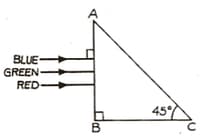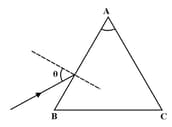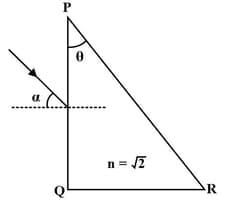Refraction through a Prism
Important Questions on Refraction through a Prism
For an isosceles prism of angle and refractive index , it is found that the angle of minimum deviation . Which of the following options is/are correct?
A ray of monochromatic light is incident on the face of prism near vertex at an incident angle of (see figure). If the refractive index of the material of the prism is , which of the following is (are) correct?
A monochromatic light is incident at a certain angle on an equilateral triangular prism and suffers minimum deviation. If the refractive index of the material of the prism is , then the angle of incidence is:
A beam of light consisting of red, green and blue colours is incident on a right-angled prism. The refractive index of the material of the prism for the above red, green and blue wavelengths are and , respectively. The prism will:

Monochromatic light is incident on a glass prism of angle . If the refractive index of the material of the prism is , a ray incident at an angle , on the face would get transmitted through the face of the prism provided.
A parallel beam of light is incident from air at an angle on the side of a right-angled triangular prism of refractive index . Light undergoes total internal reflection at the prism at the face when has a minimum value of . The angle of the prism is:
The angle of incidence for a ray of light at a refracting surface of a prism is . The angle of prism is . If the ray suffers deviation through the prism, the angle of minimum deviation and refractive index of the material of the prism respectively, are:
The refracting angle of a prism is and the refractive index of its material is . The angle of minimum deviation is:
In an experiment for determination of the refractive index of a glass of a prism by , plot, it was found that a ray incident at an angle , suffers minimum deviation of and that it emerges at an angle . In that case which of the following is closest to the maximum possible value of the refractive index?
The refractive index of the material of a prism is and the angle of the prism is . On of the two refracting surfaces of the prism is made a mirror inwards, by silver coating. A beam of monochromatic light entering the prism from the other face will retrace its path (after reflection from the silvered surface) if its angle of incidence on the prism is:
A thin prism of glass placed in air produces a deviation of in a light ray. If the prism be placed in water, what would be the new deviation?
A thin prism of refracting angle produces a deviation of in a ray of light passing through it. Find the refractive index of the prism material and the velocity of light in it.
The refracting angle of a glass prism of refractive index is . At what angle should a light ray be incident at the first face of the prism so that it emerges at the second face just parallel to the face?
A ray of light incident at on a prism suffers minimum deviation. Find the angle of minimum deviation and the refractive index of the material of the prism.
A parallel beam of light is incident on a face of a prism. By rotating the prism, the minimum angle of deviation is measured to be . Find the refractive index of the prism material. If the prism is placed in water (refractive index ), then what would be the new minimum angle of deviation?
A glass prism whose refracting angle is and refractive index is kept in a liquid of refractive index . Calculate the angle of minimum deviation for the parallel beam passing through the prism. (Given : )
The angle of a glass prism is . The angle of minimum deviation is . Without using the value of refractive index of the glass, calculate the angle of incidence for a ray of light suffering minimum deviation.
What should be the refracting angle of a prism of refractive index , so that a light ray incident on the prism at an angle of suffers minimum deviation?
A regular glass prism has refractive index for a given wavelength. Calculate the angle of minimum deviation . At what angle of incidence should a monochromatic light of this wavelength fall on the face of the prism so as to get a minimum deviation? (use and ).
Calculate the angle of minimum deviation for a glass prism of angle , the refractive index of glass being . What is the corresponding angle of incidence? Given: .




